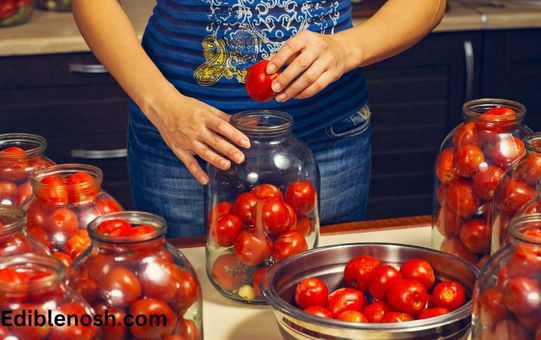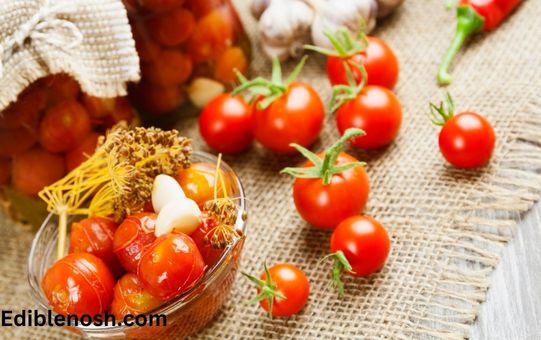Have you ever wondered if can you blend tomatoes with the skin on? Well, I did too! So I attempted it myself, and guess what? It labored!
Yes, tomatoes can be blended with their skins intact. As long as tomatoes are washed and handled properly, the skin is edible and contains nutrients like fiber. Before blending, be sure to remove any visible damage or decay.
This article will provide you with additional interesting facts and information about blending tomatoes with the skin on.
Contents
- Why Can you Blend Tomatoes with the skin on the matter?
- Will Blend Tomatoes with the Skin On Affect the Taste or Texture?
- Are There Any Benefits to Blending Tomatoes with the Skin On?
- Are There Any Risks to Blending Tomatoes with the Skin On?
- How to Blend Tomatoes with the Skin On?
- The Best Way to Enjoy Blended Tomatoes
- Recipes Featuring Blended Tomatoes
- Conclusion
- FAQs | Blending Tomatoes with the Skin On
Why Can you Blend Tomatoes with the skin on the matter?
Blending tomatoes with the skin on can have some benefits, as the skin of a tomato is edible and contains some nutrients, such as fiber. By blending the whole tomato, including the skin, you can potentially increase the nutrient content of your finished product.
Additionally, blending tomatoes with the skin on can be more convenient and save time, as you do not need to spend the extra effort peeling the tomatoes before blending. This is especially useful if you are working with a large number of tomatoes or if the tomatoes are not easy to peel.
However, it is important to note that the skin of a tomato is thin and does not contribute much flavor to the finished product. Therefore, whether or not you choose to blend the skin on or off may depend on your personal preference and the recipe you are using.
As long as the tomatoes are washed and properly handled, there are no inherent risks to blending tomatoes with the skin on.
Will Blend Tomatoes with the Skin On Affect the Taste or Texture?
In general, blending tomatoes with the skin on shouldn’t significantly affect the taste of your dish. The skin of a tomato is relatively thin and should blend smoothly with the rest of the tomato, especially if you’re using a high-quality blender.
However, if you’re using a low-quality blender or if your tomato skin is particularly tough or thick, it’s possible that the skin could lend a slightly bitter or grainy taste to your blend.

As for the texture of your blend, blending tomatoes with the skin on may make your final product a bit thicker and more fibrous. This is because the skin of a tomato contains small fibers that can add texture to your blend.
Depending on your personal preference, this may or may not be a desirable effect. If you want a smoother, silkier texture, you may want to peel your tomatoes before blending.
Read Also: Can You Blend Chopped Tomatoes To Make Passata?
Are There Any Benefits to Blending Tomatoes with the Skin On?
As mentioned earlier, blending tomatoes with the skin on can potentially increase the nutritional value of your dish.
The skin of a tomato is rich in antioxidants, such as lycopene, which has been linked to a number of health benefits, including a reduced risk of heart disease and certain types of cancer.
In addition, blending tomatoes with the skin on can also save you time and effort. Peeling tomatoes can be a tedious process, especially if you’re working with a large batch.
By leaving the skin on, you can simply wash your tomatoes and toss them into the blender, saving you the hassle of peeling each one individually.

Are There Any Risks to Blending Tomatoes with the Skin On?
There are no inherent risks to blending tomatoes with the skin on, as long as the tomatoes are washed and properly handled before blending.
The skin of a tomato is edible and contains some nutrients, such as fiber, so there is no need to remove it before blending.
However, if the tomatoes are not properly washed or have any visible damage or decay, it is best to remove the skin before blending to avoid the risk of consuming any contaminants or pathogens.
As with any food preparation, it is also important to follow good hygiene practices to reduce the risk of foodborne illness.
How to Blend Tomatoes with the Skin On?
To blend tomatoes with the skin on, follow these steps:
- Wash the tomatoes thoroughly under running water to remove any dirt or contaminants.
- Cut the tomatoes into small pieces, removing any stems or leaves.
- Place the tomato pieces in a blender or food processor.
- Blend the tomatoes until they reach the desired consistency, adding a little water or broth if needed to help the blending process.
- If desired, you can strain the blended tomatoes through a fine-mesh sieve to remove any seeds or skin.
- Use the blended tomatoes as desired in your recipe, or store in an airtight container in the refrigerator for up to 3 days or in the freezer for up to 3 months.
It is important to handle tomatoes safely to reduce the risk of foodborne illness. This includes washing your hands before handling the tomatoes and using a clean cutting board and utensils.
The Best Way to Enjoy Blended Tomatoes
There are many ways to enjoy blended tomatoes, depending on your personal preferences and the recipe you are using. Here are a few ideas:
- Make the tomato sauce: Blend tomatoes with onions, garlic, and spices to make a flavorful tomato sauce for pasta, pizza, or other dishes.
- Create a tomato soup: Blend tomatoes with broth, herbs, and spices to make a creamy tomato soup. You can also add other vegetables or beans for added flavor and nutrients.
- Make a smoothie: Blend tomatoes with fruit, yogurt, and ice to make a refreshing smoothie. You can add other ingredients, such as spinach or protein powder, to boost the nutritional value of your smoothie.
- Use as a base for dips: Blend tomatoes with beans, herbs, and spices to make a flavorful dip for chips or vegetables.
- Use as a marinade: Blend tomatoes with oil, vinegar, and spices to make a marinade for grilled chicken or vegetables.
No matter how you choose to enjoy blended tomatoes, be sure to handle and store them safely to reduce the risk of foodborne illness.
Recipes Featuring Blended Tomatoes
Here are a few recipes that feature blended tomatoes:
- Tomato soup: This classic soup is easy to make and only requires a few simple ingredients. To make tomato soup, you will need:
- 2 lbs tomatoes
- 1 medium onion, diced
- 2 cloves garlic, minced
- 2 tablespoons olive oil
- 4 cups chicken or vegetable broth
- 1/2 teaspoon salt
- 1/4 teaspoon black pepper
- 1/4 teaspoon sugar (optional)
Blend the tomatoes in a blender or food processor until smooth. Heat the olive oil in a large pot over medium heat. Add the onion and garlic and cook until the onion is translucent about 5 minutes. Add the blended tomatoes, broth, salt, pepper, and sugar (if using). Bring the soup to a boil, then reduce the heat to low and simmer for 20 minutes. Serve hot.
- Tomato smoothie: This refreshing smoothie is a great way to use up leftover tomatoes. To make a tomato smoothie, you will need:
- 1 cup diced tomatoes
- 1/2 cup diced cucumber
- 1/2 cup diced bell pepper
- 1/2 cup diced carrot
- 1 cup ice
- 1/2 cup water
Blend all of the ingredients in a blender until smooth. You can also add a handful of spinach or other leafy greens for added nutrients.
- Tomato sauce: This homemade tomato sauce is a versatile base for many dishes, such as pasta, pizza, and more. To make tomato sauce, you will need:
- 2 lbs tomatoes
- 1 medium onion, diced
- 2 cloves garlic, minced
- 2 tablespoons olive oil
- 1/2 teaspoon salt
- 1/4 teaspoon black pepper
- 1/4 teaspoon sugar (optional)
- 1 tablespoon dried basil (optional)
Blend the tomatoes in a blender or food processor until smooth. Heat the olive oil in a large pot over medium heat. Add the onion and garlic and cook until the onion is translucent about 5 minutes.
Add the blended tomatoes, salt, pepper, sugar (if using), and basil (if using). Bring the sauce to a boil, then reduce the heat to low and simmer for 20 minutes. Use the sauce as desired in your recipe.
Read Also: Can You Air Fry Tomatoes?
Conclusion
You can blend tomatoes with the skin on as long as the tomatoes are washed and properly handled. The skin of a tomato is edible and contains some nutrients, such as fiber, so there is no need to remove it before blending.
Blending tomatoes with the skin on them can be more convenient and potentially increase the nutrient content of your finished product. However, if the tomatoes are not properly washed or have any visible damage or decay, it is best to remove the skin before blending to avoid the risk of consuming any contaminants or pathogens.
As with any food preparation, it is important to follow good hygiene practices to reduce the risk of foodborne illness.
FAQs | Blending Tomatoes with the Skin On
Here are a few Questions related to Blending tomatoes with the skin:
Is It Safe To Blend Tomatoes With The Skin On?
As long as the tomatoes are washed and properly handled before blending, it is safe to blend tomatoes with the skin on. The skin of a tomato is edible and contains some nutrients, such as fiber.
However, if the tomatoes are not properly washed or have any visible damage or decay, it is best to remove the skin before blending to avoid the risk of consuming any contaminants or pathogens.
Will Blend Tomatoes With The Skin Change The Flavor?
Blending tomatoes with the skin on will not significantly change the flavor of the tomatoes. The skin of a tomato is thin and does not contribute much flavor to the finished product.
Can I Blend Any Type Of Tomato With The Skin On?
You can blend any type of tomato with the skin on, as long as the tomatoes are washed and properly handled. This includes red tomatoes, cherry tomatoes, and heirloom tomatoes.
Do I Need To Remove The Seeds Before Blending Tomatoes With The Skin On?
It is not necessary to remove the seeds before blending tomatoes with the skin. However, if you prefer a smoother texture, you can strain the blended tomatoes through a fine-mesh sieve to remove the seeds.
How Can I Use Blended Tomatoes With The Skin On In Recipes?
Blended tomatoes with the skin on can be used in a variety of recipes, including tomato sauce, tomato soup, dips, and marinades.
They can also be used in smoothies and other drinks. Just be sure to handle and store the blended tomatoes safely to reduce the risk of foodborne illness.

